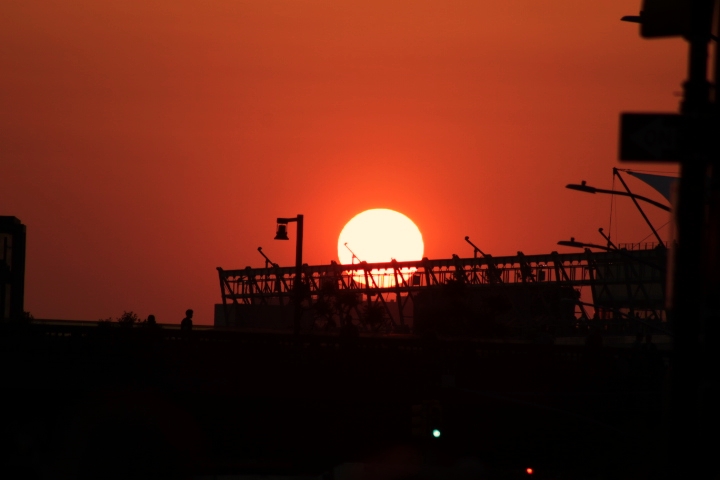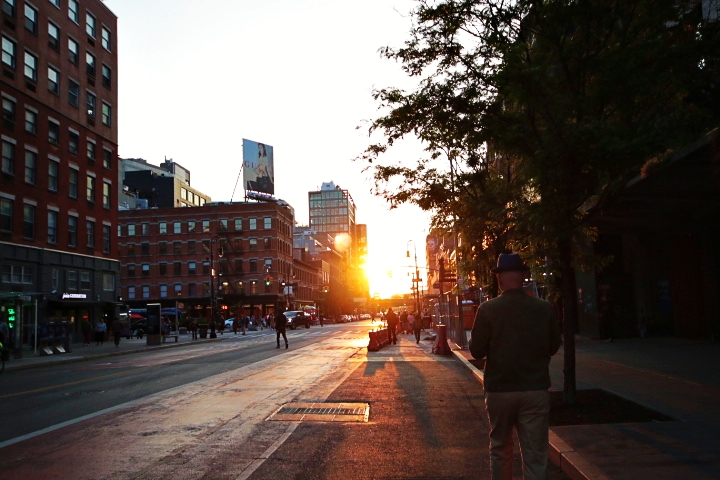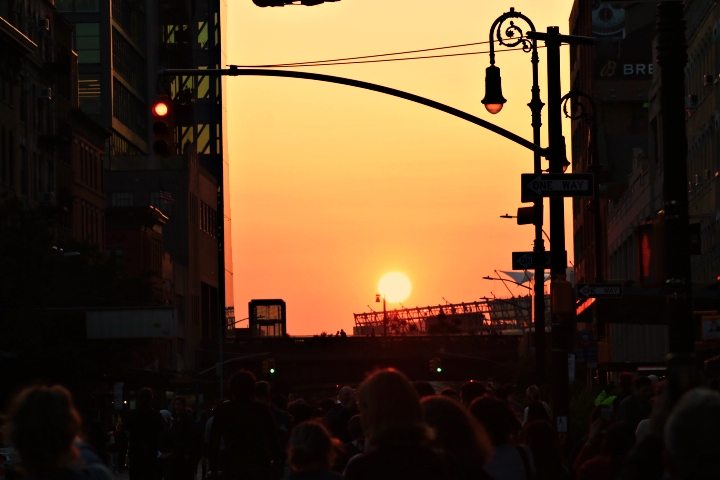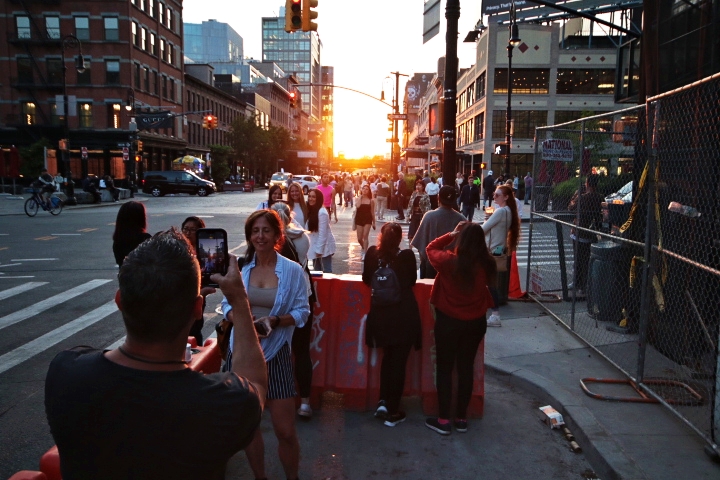
Manhattanhenge: a Celestial Phenomenon.
It isn’t visible in Brooklyn, but it is still a momentous event. Manhattanhenge makes appearances multiple times a year. It is a play on Stonehenge, which is a prehistoric, mysterious monument in the UK. It was built to track the summer and winter solstices. When viewed from the center ring of boulders, the sun aligns with boulders within the outer ring on solstice days. Unlike Stonehenge, Manhattanhenge was completely unintentional. Manhattanhenge is a celestial phenomenon.
Manhattanhenge was coined by astrophysicist Neil deGrasse Tyson.
He is the Director of the Hayden Planetarium at the American Museum of Natural History. Tyson isn’t a Brooklynite, but we love him none the less. He showed a deep love for space and astronomy from an early age. In high school he obsessively studied astronomy and gave speeches on it at only 15 years old. Around this time Tyson went to Stonehenge and saw other similar structures. These inspired Manhattanhenge.
Manhattanhenge: a celestial Phenomenon.
For two days in May and two in July the sun perfectly aligns with the Manhattan crosstown grid. There are also Manhattanhenges during winter. These aren’t as popular since they are obviously colder. Manhattan is about 30 degrees off of true north. This allows the sun to set precisely between the streets running west to east during Manhattanhenges. Lower Manhattan is also flat, otherwise there wouldn’t be a Manhattanhenge. The specific date varies year to year. Usually it occurs on May 29 and is only partially visible. Then on May 30 the sun makes a complete descent down the center of the street. In July the full Manhattanhenge is viewable on July 12th. Then on July 13th it is only partially visible.

The best streets to observe this celestial phenomenon are 14th, 23rd, 34th, 42nd, 57th, and 79th in Manhattan.
These are good viewing locations because they are wide streets, and they are properly aligned. It’s also visible from the Tudor City Overpass in Manhattan and Hunter’s Point South Park, Long Island City, in Queens. You could view it anywhere along the East River as long as you have a clear view. Neil deGrasse Tyson says you should position yourself as far east as possible, while still having the Jersey City skyline within view if you’re in Manhattan.
Manhattanhenge: a reminder that the universe exists.
It connects Brooklynites and NYC residents to nature in a way that few things do around here. It is one of the only annual, celestial phenomenons that is readily viewable in NYC. Living in the concrete jungle of NYC it is easy to forget that there is a universe. People living in NYC are exposed to many that things happen completely outside of the realm of humans. Living conditions in NYC are unique compared to much of the world. Most places are dictated by the rising and setting of the sun, but that doesn’t apply as much for NYC. After all, this is called the city that never sleeps for a reason.
Some edifices and apartments in NYC won’t even be touched by sunlight until noon.
Some apartments will never receive direct sunlight in the totality of their existence. There are man-made canyons of skyscrapers in lower Manhattan. They effectively cause twilight to occur two to three hours earlier in those spots. The night sky has been almost completely blotted out due to light pollution. This negatively impacts species not only living within NYC, but those living outside of it as well. Brooklynites and NYC residents have lesser or no connection to daily celestial events. This is why Manhattanhenge is a celestial phenomenon and is cherished by so many.

Manhattanhenge: a celestial phenomenon.
It is also a reminder of our distant past. No matter how modern we are there is no denying the awe-inspiring power of the sun. One of the things that makes humans human is our apt ability at pattern recognition. For perhaps millions of years the earliest humans relied on the sun and stars for direction. Then at some point humans noticed that certain constellations appeared only at certain times of the year.
Stars and their constellations became markers for the passing of the seasons.
Modern society, and thus Brooklyn and NYC, would have never existed without extensive knowledge of the stars. Early agriculturalists closely followed the motions of the stars and moon cycles. These would tell them when to perform certain actions such as tilling the soil, sowing seeds, and gathering crops so that the best harvests could be produced.
Stonehenge was built as a technological monument. It is essentially a solar clock.
Its purpose was to help people more accurately and easily track approaching solstices. There are many other lesser known examples of this type of structure. Many examples of ancient architecture were aligned to the stars with precise accuracy. A well-known example is the pyramid of Giza, which is aligned to true north with almost perfect accuracy. One could argue that the stars are literally a foundation for ancient architecture and Western civilization.
Solar events produce different types of reactions for different people.
Obviously for Brooklynites and NYC residents, Manhattanhenge is a novel experience. The sun has little to do with our day-to-day lives. To people in older cultures, solar events produce joy because they represent the eternal. Needless to say, when we take notice of the sun in NYC it is truly a special occasion. Technology has largely taken over the need to track celestial events for most of the world. The sun is the only god that has ever been proven to exist. Verily, whether you are someone from a tribe or a city slicker, the sun is a magnificent thing to witness.

Manhattanhenge brings about many questions about our relationship to the sky.
The sun is a star like all of the stars in the Milky Way. Humans have existed for hundreds of thousands of years with a clear view of the sky. We relied on the night sky for our benefit as a species. It may have also helped evolve our imaginations and spiritual inclinations. It’s only within the last 100 years that humanity has existed with a diminished connection to the night sky. As previously stated, light pollution is wreaking havoc on wildlife. Nobody truly knows if people living with lessened access to the night sky are suffering for it. However, who can deny the serenity of sitting under a dark canvas dotted with sparkling bits of light?
Manhattanhenge is a celestial phenomenon.
There is a much larger world outside of NYC, but we are cut off from it in many ways. It would be ridiculous to suggest tearing down all of these buildings. Who would want that anyhow? We are the original skyline that other cities emulate. Is there room for things that are not oriented toward the realm of humans in NYC though? Perhaps one day in the not-so-distant future NYC could lead the world with scheduled ‘lights out’ nights. NYC residents and people living in parts of Long Island and Upstate New York, would be able to experience the night sky in its full glory and wonder.

Don’t fret if you missed Manhattanhenge on May 29th or 30th. You’ll have another opportunity in a little over a month for a chance to view it. You can also view it in the winter. But the next Manhattanhenge dates are July 12th and 13th, respectively.
Thank you so much for your attention and input. Please stay tuned for future Brooklynites posts.
Read about astrophysicist and creator of Manhattanhenge, Neil deGrasse Tyson:
https://en.wikipedia.org/wiki/Neil_deGrasse_Tyson
Read about Manhattanhenge:
https://www.amnh.org/research/hayden-planetarium/manhattanhenge
Read our previous post on Celebrate Brooklyn!:
https://172-234-236-52.ip.linodeusercontent.com/celebrate-brooklyn-2023-and-its-history/

